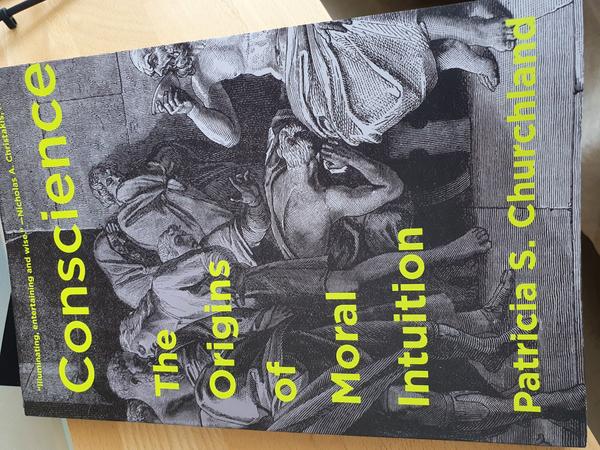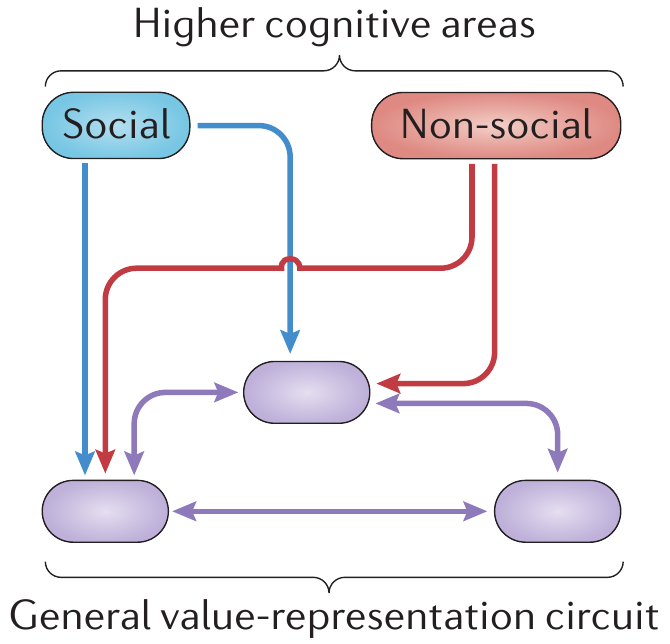Books - Read and Enjoyed
Conscience
The Origins of Moral Intuition
Patricia S. Chruchland
Norton & Company, 2019

Conscience is a major component of the assessment and decision making system in the human brain. By introspection, we all have an experience of our own, private conscience and how it assesses a situation and guides our actions. Our conscience talks to us when we see someone in need in the street, when we observe two children playing in the sandbox, one being obviously mean to the other, when we note that an acquaintance treats her two children unjust, punishing one when the other would deserve it, when we read about rising inequality or child abuse in the newspaper, and on many other daily occasions.
We are not alone with feeling the strong force of conscience. The records of history and literature are full of references to its powerful voice.
I cannot and will not recant anything, for to go against conscience is neither right nor safe. Here I stand, I can do not other, so help me God. Amen.
(Martin Luther)
There comes a time when one must take a position that is neither safe, nor politic, nor popular, but he must take it because conscience tells him it is right.
(Martin Luther King Jr., A Testament of Hope: The Essential Writings and Speeches)
If all the world hated you and believed you wicked, while your own conscience approved of you and absolved you from guilt, you would not be without friends.
(Charlotte Brontë, Jane Eyre)
Wrong does not cease to be wrong because the majority share in it.
(Leo Tolstoy, A Confession)
A Native American elder once described his own inner struggles in this manner: Inside of me there are two dogs. One of the dogs is mean and evil. The other dog is good. The mean dog fights the good dog all the time. When asked which dog wins, he reflected for a moment and replied, The one I feed the most.
(George Bernard Shaw)
Character is doing what you don’t want to do but know you should do.
(Joyce Meyer)
Give me the liberty to know, to utter, and to argue freely according to conscience, above all liberties.
(John Milton, Areopagitica)
In matters of conscience, the law of the majority has no place.
(Mahatma Gandhi)
The only tyrant I accept in this world is the ‘still small voice’ within me. And even though I have to face the prospect of being a minority of one, I humbly believe I have the courage to be in such a hopeless minority.
(Mahatma Gandhi)
The one thing that doesn’t abide by majority rule is a person’s conscience.
(Harper Lee, To Kill a Mockingbird)
No guilt is forgotten so long as the conscience still knows of it.
(Stefan Zweig, Beware of Pity)
One remarkable, often mentioned feature is, that the judgments of the inner voice called conscience is not subject to majority vote and it applies, whatever others may think; it applies even if nobody else knows about your thoughts or deeds.
So who’s voice is this inner voice? What is the source of our conscience?
Patricia Churchland’s answer is a biological one and the evidence she marshals for her case is strong. Conscience is wired into our brains, it serves a distinct function and has been selected for due to evolutionary benefits.
Where does our conscience come from?
Although the most of the book discusses biological arguments and studies with brain computer tomography scans, recording signals from neurons, measuring neurotransmitter activities, and the like, Churland devotes one chapter to the main philosophical schools that propose to explain the origin of conscience. She distinguishes two broad categories: rule based morality and wisdom seeking.
Rule based morality
Churchland reviews three main possible foundations of rule based morality and rejects them as being flawed: religion, pure reason and utilitarianism.
Religion
Using a religion as foundational basis of morality has the problem that there are several competing religions and there is no independent way of deciding, which one is right or more basic. Even within a religion there are branches and sects that do not agree. Also, religious leaders routinely find many reasons for exceptions from the strict religious rules. For instance the ten commandments of Christianity have been systematically broken by the highest Christian leaders throughout the 2000 years of Christian history. Moreover, there are religious systems like Buddhism or Confucianism that do not offer a set of clear rules but are nonetheless certainly not ethically inferior, such as Buddhism.
A fundamental and subtle problem of any religion based morality has been beautifully laid out by Plato in Euthyphro:
> As they are walking to court Euthyphro confidently explains to
> Socrates that the Gods are the source of right and wrong,
> giving the impression that he thinks Socrates is a bit witless
> to ask about the origin of morality. Socrates muses, Do the
> gods say something is right because it *is* right (hence is it
> right on independent grounds), or is something right because
> the gods *say* that it is right (saying makes it so)?
>
> (p 153)
Here is a fundamental dilemma of all religion based morality: If we accept the first option, then the Gods are only the conveyors of moral information, but not their origin. If we accept the second option, then whatever the Gods say, is right, even if it feels horribly wrong.
Phrased in this way, neither alternative is attractive and feels like a solid ground on which to base morality or a grand ethics.
Pure reason
Proponents of this category are Thomas Aquinas, Kant, and the contemporary philosopher Thomas Nagel.
Thomas Aquinas explained
all acts of virtue are prescribed by the natural law: since each one’s reason naturally dictates to him to act virtuously.
(<https://en.wikipedia.org/wiki/Thomas_Aquinas#Ethics>)
Immanuel Kant formulated his vision of rationality based ethics:
The ground of obligation must be looked for, not in the nature of man nor in the circumstances in the world in which he is placed, but solely a priori in the concepts of pure reason.
(p156)
Thomas Nagel rephrases this position in modern language:
People have, to greater or lesser degrees, a capacity for reasoning that follows autonomous standards appropriate to the subjects in question, rather than in slavish service to evolutionary given instincts merely filtered through cultural forms or applied in novel environments. Such reflection, reasoning, judgment and resulting behavior seem to be autonomous in the sense that they involve *exercises of though that are not themselves significantly shaped by specific evolutionary given tendencies, but instead follow independent norms appropriate to the pursuits in question.
(p154)
For Churland this is hard to swallow and she comments:
according to this approach, if rules are proper moral rules, they reflect “independent, stable moral truths” apprehended by our rational faculty. Independent in this context means independent of social instincts. (I am repeating this because I am still incredulous at the statement of this position.) The proper moral rules - the real ones, as it were - are universal, and hence, cannot vary across cultures. Any culture that does not adhere to those rules is morally wrong. In short, the proper rules are rather like stable mathematical truths that never vary. The truth does not vary, even if cultural beliefs vary. Everywhere, 2+2=4.
(p154ff)
The problem is to define and agree on what pure reason or rationality is. It is therefore substituted with consistency. A set of rules must be consistent and cannot contradict itself. Further, the assumption goes, people do not agree to rules that put themselves at a disadvantage, because that would not be rational. However, that can in fact happen and Churchland refers to fanatics as examples:
consider a real Nazi rule that children with autism should be euthanized. A committed Nazi on the Kantian team might eagerly agree that this rule should apply to all people under all conditions, even himself, were he unfortunate enough to be born with autism. He is not contradicting himself. According to Kant therefore, the consistent Nazi does rationally endorse that rule, and thus the rule is a moral rule. Notice, that any run-of-the-mill fanatic or extreme ideologue can adopt the Nazi tactic. All he has to do is be logically consistent. All he has to do is not contradict himself. Feelings of aversion or disgust, in the Kantian view, are irrelevant.
(p157)
Utilitarianism
Utilitarianism has become influential in the 19th century promoted by Jeremy Bentham, John Stuart Mill and others. Essentially it says
Act so as to produce the greatest happiness for the greatest number.
(p161ff)
While this principle has been used as guide in formulating legislature with significant benefits, there are severe difficulties when considered as foundation for morality. First, happiness is impossible to universally define for a species as varied as homo sapiens. The preferences, inclinations, interests and potentials are just so different across countries, cultures and times, that any attempt for a precise definition seems hopeless; in particular, because the utilitarian principle requires to quantify happiness and do arithmetic on it. Furthermore, this principle may suggest to endorse actions that we otherwise find repulsive, like “producing babies to harvest their organs, assuming a few are sacrificed and many are saved” (p163), or executing a few leaders of an insurrection to give stability and prosperity to the country. Finally, a tyranny of the majority against a minority may be perfectly fine by utilitarian standards but contradict the conscience of many of us.
If applied rigorously, the utilitarian principle seems to be as inadequate a foundation for morality as rationality or religion. So what then is the basis of our conscience?
Wisdom seeking
Wisdom seekers reject the idea that a set of rules serve well in describing moral behavior or guiding people in leading a virtuous life. Churchland lists Buddhism, Aristotle, Adam Smith and David Hume falling into this camp.
[The Dalai Lama] explained that strict rules could be an impediment, whereas flexible guidelines were more apt to aid real-life decision-making that involved an individual’s particular history and situation. Stories, admirable role models, and the development of strong social habits were more effective as teaching tools than was rote rehearsal of inflexible rules.
(p 149)
Aristotle took a similar stance in his Nicomachean Ethics.
Aristotle’s view was that balance in moral judgment, as in practical judgment generally, is a skill. He thought we would all do well to culture that skill as effectively as possible, as a defense against social tumult, and as a way of getting through trouble.
(p 143)
Churchland argues that the concept of wisdom seeking as basis for our conscience is more in line with biological evidence. Moral judgment is a skill, like walking or language, that our brain is strongly predisposed to acquire but that has to be learned, improved and refined in a social context by observing and interacting with others.
Reward and value system
Churchland contends that there are no rules out there that form a basis for morality independent of humans, because the origin of our conscience is that humans have to solve a constraint satisfaction problem to make decisions. When making decisions like which prey to pursue, which mate to select, which fellow human to befriend or to punish, we have to consider many constraints and objectives. Constraints are due to practical limitations of resources, energy and time. The expected actions of others, be them friends or foes, have also to be considered in this equation. Objectives of actions are to maximize the availability of resources, like food or money, to maximize the probability of survival or prosperity, etc.
To deal with these complexities the human brain has a reward and value system, that guides through the decision making and allows to learn from observation and own experience.

The reward system evaluates the expected outcomes of a decision and assigns values to them quantifying how beneficial these outcomes will be. Each decision always has many implications which have to be weighed against each other. Eating a cake or a fish all by myself will maximize my nutrient intake, but sharing with friends will give me good-will which could be beneficial in the future. So the reward based decision system evaluates the possible outcomes of a decision, weighs the pros and cons against each other and then decides. After the decision is taken, the actual outcome is observed and again evaluated. If the predicted values are identical with the actually observed values, my brain has obviously a very good model of the world. But more often than not the predicted values are different from the actual values which is an opportunity to learn and improve the model of the world.
This process is called re-enforcement learning. The method works for my own actions, when I predict the consequences of my decisions and learn from my mistakes, but it works as well by observing others. To predict the consequences of other people’s decisions and then compare them with the actually observed consequences, is also a powerful learning method. Even better, we observe the values that other people (role models) assign to situations and use them in our future predictions. This is called imitation learning and is so powerful because we do not need to observe the actual consequences of an action. We rely on and use the value prediction of our parents, elders and other role models. That is a tremendous shortcut to learning and is part of the basis for humans being a social species and being able to base our knowledge on what previous generations have already learned.
There is empirical evidence that reward based decision making is realized by the brain circuitry. The reward system evaluates both social and non-social situations and there is some evidence that the underlying mechanism is the same for both, although they use different facts and knowledge.
Since humans are a highly adaptive and intensely social species, the actual values assigned to situations have to be learned. They are not hardwired in the DNA and fixed at birth, but they are developed during childhood and refined throughout life.
Thus the voice of conscience, according to this theory, comes from the reward and value system that has been configured throughout childhood by means of imitation and re-enforcement learning. This theory explains nicely why it is culture dependent and why there are no fixed rules that are universal and independent from our biology and culture. It can also explain why the voice of conscience is often clear and strong but its origin is not subject to introspection. The reward and value system has been learned over a period of many years, but the specific, countless observations and experiences that were the basis of this learning, are not recorded and not available to our introspection.
What do we know today?

The book describes and reports many experimental studies of brain signal recordings, computer tomography scans and more cruel experiments with animals, that shed light on specific aspects of the inner workings of the brain. Although there are many fascinating examples and insights, described in a vivid and engaging language, to some degree I feel that there are large, white areas on the map of our understanding of the brain, which are not properly acknowledged as such.
To give an example, chapter 2, “Getting Attached”, left me a bit confused because I did not really figure out, what we know about how attachment works at the neuron circuit level.
The emphasis in the chapter is on oxytocin and other neurotransmitters, and how they are implicated in bonding behavior. In a key study prairie voles and montane voles are compared. Prarie voles are monogamous, mating with one partner for life, and montane voles are polygamous, they mate and separate. It has been found that the key cause for this difference is the difference in the density of oxytocin receptors in the nucleus accumbens and vasopressin receptors in the ventral pallidum, both are subcortical structures in the brain. The causal connection could be established by:

-
blocking oxytocin receptors lead to recuced pair-bonding in prairie voles;
-
injecting oxytocin into the brains of virgin prairie voles led to pair-bonding (which otherwise only occurs after mating);
-
genetically increasing the vasopressin receptors in the ventral pallidum in prairie voles increased attachement behaviors;
-
genetically increasing the vasopressin receptors in the ventral pallidum in montane voles caused them to behave like prairie voles.
Then the text explains the neural circuit connections between regions in the brain that contribute to “Wanting” and “Liking”, and the reward system that generates pleasure, pain regulation, mating and maternal behavior such as milk production, cuddling and licking, stress regulation, recognition of ones off-spring, mate, kin and friends. These neural pathways often use the same neurotransmitters like oxytocin.
I acknowledge and appreciate the main conclusions, which are that oxytocin and other neurotransmitters play a major role on the covered social behavior, and that certain brain regions and neural pathways contribute to this behavior. However, I feel that eventually we desire a deeper level of understanding. For instance, there are brain structures involved in “Wanting” and “Liking” and in recognizing ones offspring, such as the nucleus accumbens in the subcortex. But how exactly is the recognition of an off-spring achieved? What is the neural circuit that does it and how does it do it? And how is the recognized individual valued as an offspring that needs to be protected and cared for?
The text does not explain, if we can answer these questions or not. Do we know the details, and they are too complex to explain here, or simply out of scope? Or do we have no idea how that works at the neural circuit level? The text somehow seems to suggest that we already know an awful lot of what needs to be known except a few details that will be found out soon. But to me the level of understanding that really matters, the details of the neural circuitry that generates the social behavior, is missing; or not described, anyway. The focus on the role of oxytocin and other neurotransmitters seem to me a focus on something that we can measure and validate, while ignoring the aspects that are needed for a deeper understanding, because they are harder to decipher. I definitely see the value of what is explained and the great progress that has been made in understanding some causal effects of neurotransmitters, brain structures and brain connections, but what I miss is a description of what we still lack, what we still need to know to obtain a real, deep understanding of the phenomena.
In summery it seems to me we have very good overall understanding of
how our brain works and how it produces conscience, and other relevant
behavior like decision making and valuation of situations. We also
know many bits and pieces of specific mechanisms, specific brain
regions, neuro-transmitters, and relation to genetic code in the
DNA. At the same time lots of fundamental understanding is still
missing. We do not know how specific content is represented in the
brain, or where it is stored. E.g. how is the preference of mating
partners, if they are tall, or heavy, healthy or sickly, represented?
Which parts of the brain circuit, which neurons would I have to change
if I would want to increase the preference for smaller size of mating
partners? It seems we still know little about the micro-level brain
circuitry and how it relates to the functions of storing,
communicating, and manipulating content.
At the same time progress seems to be fast and I expect that within two decades we will have a much more complete understanding of architecture and functionality of the brain circuitry on all levels from Neurons up to the manipulation of symbolic representation of rela world situations.
(AJ June 2022)
